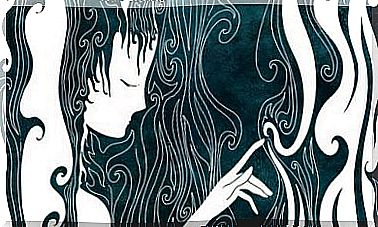Mental Imagery Repetition Therapy

Nightmares cause terror and anguish and wake us up with a start. Additionally, when these nightmares become chronic, they can seriously affect a person’s sleep quality, or even influence their daytime performance. Mental imagery repetition therapy is one of the most effective techniques for treating this phenomenon.
We’ve all had nightmares at one point or another in our lives. It is therefore a normal process of sleep. It is generally not a pathology. And, nightmares don’t cause any problems beyond the discomfort you feel. However, it is considered to be a sleep disorder when these unpleasant dreams become recurrent.
In the main diagnostic classification manuals, nightmares are considered a parasomnia. They therefore involve the repeated appearance of dreams which generate intense fear. These usually occur during the Rapid Eye Movement (REM) phase and their content is in some way threatening to the person.
Chronic nightmares have a significant impact on the quality of sleep. Indeed, they can cause the person who suffers to have insomnia or to be afraid of sleeping or being in the dark. It is also likely that the person will develop behaviors that interfere with sleep, such as leaving the lights on or sleeping at irregular hours.

Why do nightmares happen?
Although we do not yet have sufficient scientific knowledge to determine the cause and origin of nightmares, factors influencing their occurrence have been discovered:
- First of all, nightmares are more common in children and, to a lesser extent, in adolescents. They are part of the ripening process and tend to disappear over time
- They occur more during times when the person is under high psychosocial stress. In this situation, nightmares can serve as a coping mechanism. Indeed, when the stressor in sleep occurs, the person explores various ways of dealing with it.
- We often associate nightmares with other disorders such as anxiety, depression and especially the syndrome of post-traumatic stress
- People who have trouble regulating their emotions tend to have nightmares more often
What is mental imagery repetition therapy?
Mental imagery repetition therapy is one of the most studied and effective procedures in the treatment of nightmares. It is a cognitive technique based on modifying the content of sleep.
The goal is to consciously modify certain details of the nightmare. The goal is therefore to make the nightmare a pleasant story. In this way, the person is able to take control of the dreamed events and modify them.
Mental imagery repetition therapy, step by step
1. Change beliefs
First of all, it is necessary to change some beliefs that the person may have about nightmares. We need to convey to her the idea that nightmares are not something you can’t control, but rather an acquired habit that we can change.
On the other hand, it is important for the person to understand that once they are chronic, nightmares cease to be useful and no longer perform their function. It is therefore time to approach them, to modify them during the evening so that they become more pleasant.
2. Work on visualization
The next step is to assess the person’s ability to imagine scenarios in a vivid way. To do this, he is asked to work on his imagination by creating pleasant scenes in his mind. He is also taught techniques to control the appearance of unpleasant images during visualization practice.

3. Face the nightmare
At this point, the person is asked to choose the nightmare they are going to work on by writing a story of the nightmare. Then, the patient is encouraged to modify the content of his nightmare and rewrite it by describing in detail this new sequence of images.
Finally, the person is asked to spend between 5 and 20 minutes per day mentally reviewing the edited story. The idea is that, by repeating this modification during the day, it transfers to the dream as a continuity.
The effectiveness of mental imagery repetition therapy
Finally, if one is consistent in applying the technique, the nightmares quickly diminish. In addition, the results are maintained in the long term. The quality of sleep will also be improved and the discomfort associated with the nightmares experienced by the person, reduced.










